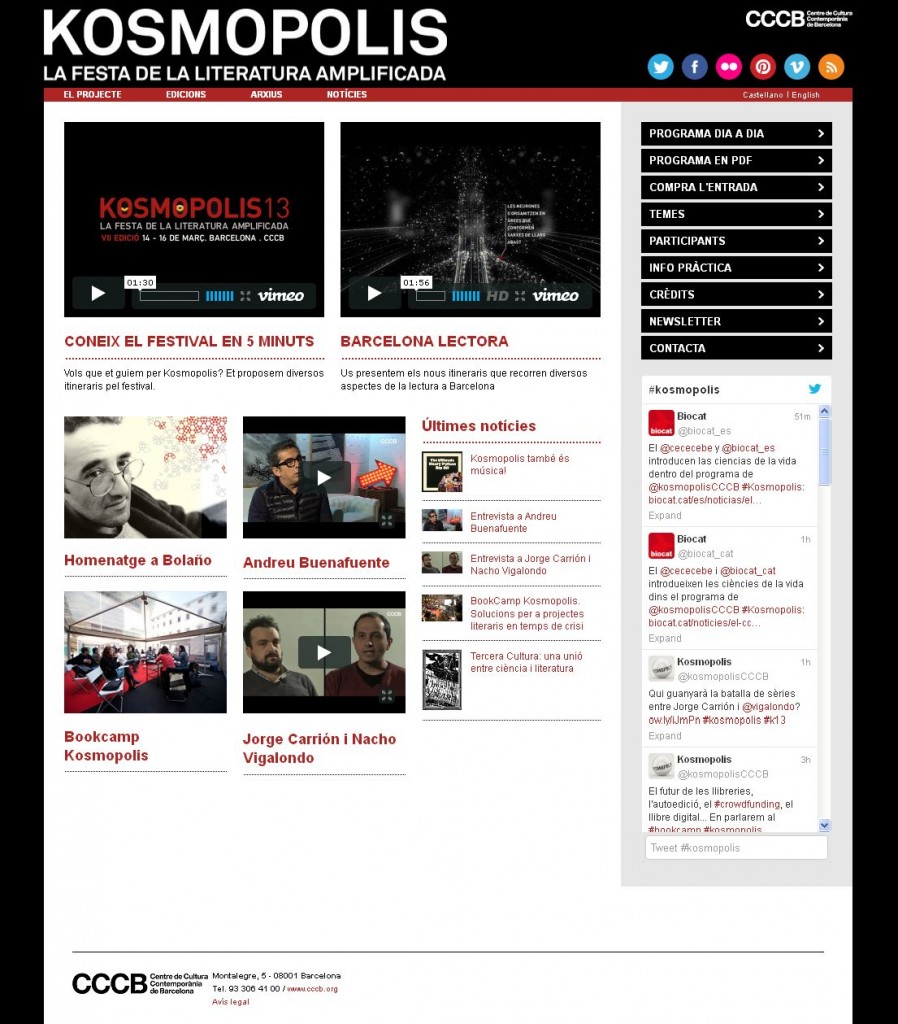 Because Kosmopolis is amplified literature and because we want the festival to reach you wherever you are, we’re streaming some of the talks and activities. We’ve also programmed online coverage of the festival on Twitter so you at home can follow us and take an active part in the conversation # Kosmopolis.
Because Kosmopolis is amplified literature and because we want the festival to reach you wherever you are, we’re streaming some of the talks and activities. We’ve also programmed online coverage of the festival on Twitter so you at home can follow us and take an active part in the conversation # Kosmopolis.
And, if you can’t follow Kosmopolis live, after the festival we’ll be publishing videos of the principal talks and interviews with participants on the festival’s website. A team of K chroniclers will be covering the activities theme by theme to convey the atmosphere and give us summaries of the highlights.
Live programming on the Kosmopolis web
You can follow Kosmopolis live here or amplify Kosmopolis embedding the streaming code in your blog or web.
THURSDAY 14 MARCH
7 p.m. – Opening of Kosmopolis with Jaume Cabré
8.30 p.m. – Bolaño on stage: dramatized reading and debate with Àlex Rigola, Pablo Ley
FRIDAY 15 MARCH
6 p.m. – Martian time slip: talk with Fernando Abilleira, Jacinto Antón, Lara Saiz
7 p.m – Roberto Bolaño: gestation of a myth – debate with Jaume Vallcorba, Jorge Herrralde, Pere Gimferrer, A.G. Porta and Juan Antonio Masoliver Ródenas
8 p.m. – Pages written on Jacob’s ladder: poetry reading in tribute to Roberto Bolaño with Olvido García Valdés, Chefa Alonso
8.30 p.m. – Talk by Dave McKean: the blue tree
#KOSMOPOLIS on Twitter
 Once again, at @KosmopolisCCCB we explain the festival’s functioning, give information about times, and publicise the highlights and the public’s comments.
Once again, at @KosmopolisCCCB we explain the festival’s functioning, give information about times, and publicise the highlights and the public’s comments.
To follow us and take part in the Kosmopolis conversation with comments and questions for speakers, use these hashtags:
#K13 and #Kosmopolis – General information about all the activities at the festival
#BCK13 – Tweets about Kosmopolis BookCamp
#LiterDig – Tweets about the meeting of digital magazines being organized by Revista de Letras
The @cececebe and @CCCBlab accounts will provide further practical information about the festival.
Kosmopolis Web: news, videos and chronicles of the festival
 We’ll be updating the festival website daily with the latest photos and news. This year, bloggers and experts in the various themes will be collaborating with Kosmopolis to cover activities. And, when Kosmopolis ends, we’ll give you the festival chronicles, with videos of interviews and talks.
We’ll be updating the festival website daily with the latest photos and news. This year, bloggers and experts in the various themes will be collaborating with Kosmopolis to cover activities. And, when Kosmopolis ends, we’ll give you the festival chronicles, with videos of interviews and talks.
The K13 chroniclers are:
Albert Forns, journalist and writer, covers Kosmopolis BookCamp.
Marta Palomo and Jesús Méndez, a biologist and a Medicine graduate, and authors on the popular science blog DixitCiencia, will be following all activities related to science and literature.
Breixo Harguindey, collection director at Rinoceronte Editora and comic expert, will be following the trail of Dave McKean and Paul Gravett.
The CCCB’s team will be following the rest of activities: Lucía Calvo chronicles the activities in tribute to Roberto Bolaño, and Alba Conesa, Clara Bofill, Maria Farràs and Eva Rexach will be managing the CCCB’s various Twitter accounts during the festival.








